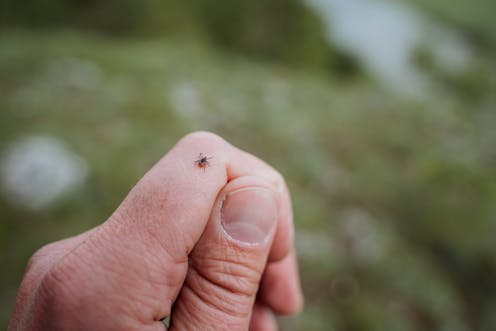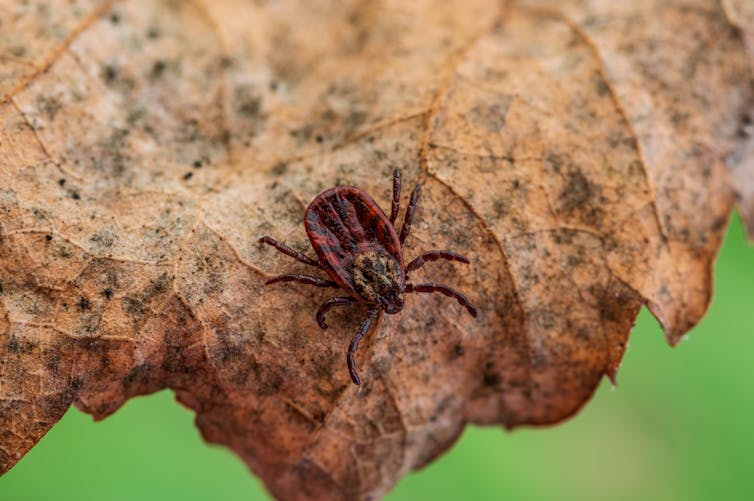
Earlier this year, the UK Health Security Agency confirmed a case of tick-borne encephalitis – a potentially deadly virus carried by ticks that causes brain inflammation. A British man is also said to have contracted alpha-gal syndrome after being bitten by a tick. This condition can trigger a fatal allergy to red meat.
The ticks that carry these pathogens are already common in other parts of the world, including Europe and North America. But in light of these reports, many may be wondering whether ticks and tick-borne diseases are a growing risk in the UK.
Are tick numbers increasing?
It’s difficult to provide a straightforward answer as to whether tick populations are rising in the UK. This is because tick abundance surveys tend to be fairly localised and only done during short, sporadic time frames.
This is important, as the tick lifecycle typically spans around two years, but may last several years depending on whether or not it feeds. Tick populations will also vary depending on the local populations of the animals they use as hosts (such as rodents and birds).
So given the sporadic data we have on tick density, it’s difficult to estimate how much tick populations have really increased, and whether this is part of a long-term trend. But we are seeing both an upsurge of some species and the establishment of new ticks in the UK in recent years.
Why are things changing?
Climate change undoubtedly has had a huge impact on tick infestations.
This has been particularly noticeable in colder regions, such as in parts of Canada where ticks had not previously been recorded. In the UK, recent milder winters mean ticks are being sighted earlier in the year than normal.
A push to build parks and green spaces, particularly in towns and cities, is another factor which can influence tick abundance. While green spaces have many benefits to human health and the environment, these can also provide a suitable habitat for ticks – with a high risk of exposure to humans and their pets.
On farms, areas set aside to preserve wildlife also provide excellent tick habitats. These are often close to paths used by hikers.

Animals also drive up tick numbers. Deer, rodents and ground-foraging birds (such as blackbirds) are all important hosts. Migratory birds also aid in the spread of ticks in the UK as they carry them from other countries. Pets travelling from outside the UK are also responsible for the importation of at least ten tick species.
What health risks do ticks carry?
In the UK, the most common tick species is the castor bean tick (Ixodes ricinus). The red sheep tick (Haemaphysalis punctata) and the newly established ornate dog tick (Dermacentor reticulatus) are also becoming more common.
Ticks can carry harmful germs.
Lyme borreliosis (also known as Lyme disease) is one such example. In the UK, this is spread by the castor bean tick. Symptoms of Lyme disease include a circular or oval rash around the bite area, as well as fatigue and flu-like symptoms that can become chronic if untreated.
The incidence of Lyme disease is fairly low in the UK (just under 3% of ticks carry it). But in other parts of Europe, between 9-22% of ticks carry Lyme disease – and this number is rising.
Tick-borne encephalitis virus has also now become established in the UK. This is also spread by the castor bean tick. It initially causes flu-like symptoms, but may lead to brain inflammation. Cases of tick-borne encephalitis virus are still rare in the UK.
À lire aussi : Tick-borne encephalitis virus in the UK – what it is and how to protect yourself
Ticks can also transmit a pathogen that causes babesiosis, which affects humans and animals. This illness attacks the red blood cells, leading to anaemia.
Recently, some fatal cases in dogs were associated with the Dermacentor reticulatus tick. This tick isn’t native to England but has now become established in Essex and the south-east coast.
The red sheep tick has also been reported in South Downs National Park. This carries bacteria called Borrelia miyamotoi, which causes tick-borne relapsing fever – an infection characterised by recurrent bouts of chills, sweat, muscle aches and vomiting.
Public health officials are particularly concerned about the spread of the lethal viral infection Crimean-Congo haemorrhagic fever. This disease causes fever, muscle aches and dizziness, which can rapidly progress to kidney deterioration or sudden liver failure in just a few days. It has a 10-40% fatality rate.
Crimean-Congo haemorrhagic fever is transmitted by Hyalomma ticks, which are most common in the Mediterranean basin. Although this tick hasn’t been detected in the UK, cases have been spreading throughout Europe in recent years – with recent cases reported in Spain.
Protecting yourself
The best way to prevent tick-borne diseases is by avoiding tick bites.
Avoid tall grasses and areas where ticks thrive (such as moorlands and woodlands), especially during the warmer months. If you planning on going outdoors, stay on marked paths and cover yourself with long clothing so ticks can’t bite you. Insect repellents can also help.
If you find you’ve been bitten by a tick, you should remove it as soon as possible to avoid risk of infection. If you become unwell after being bitten by a tick, it’s important to visit a GP as soon as possible.
Sally Cutler has previously received funding from ECDC and is currently a member of a COST-Action (PRAGMATICK) on tick-borne diseases.
This article was originally published on The Conversation. Read the original article.







